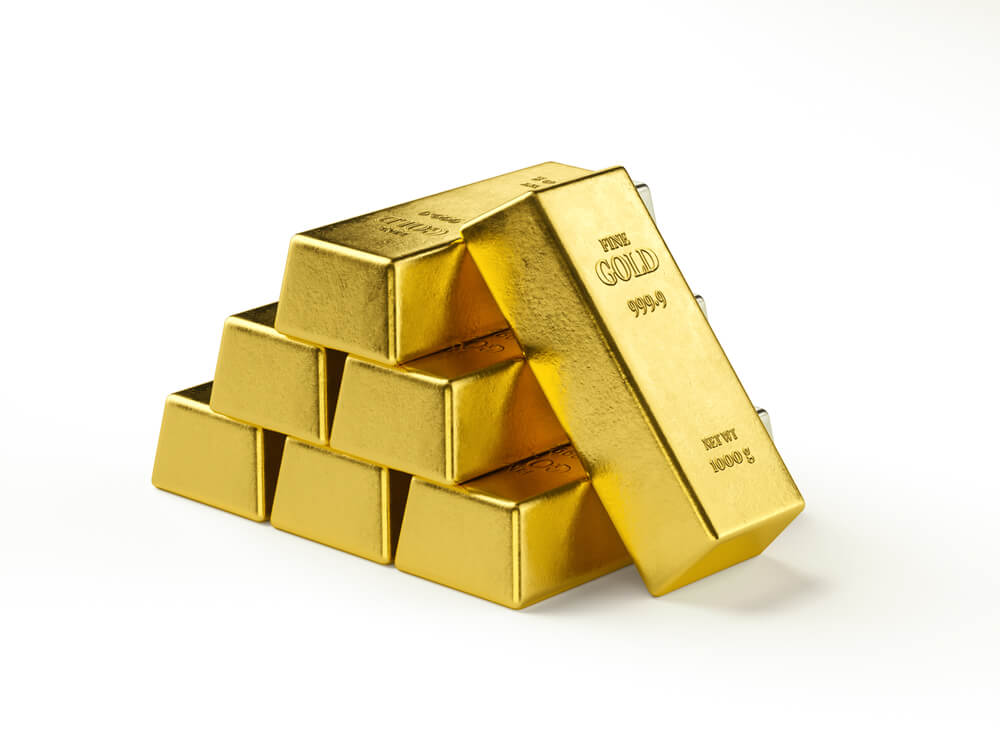
Everything There Is to Know About Gold Bars
When talking about gold, most people think about jewelry and gold coin. Gold jewelry is the first choice for the masses who don’t look at gold purely for investment purposes. Those keen on investment potential look at gold coins and gold bars. The term “gold bar” conjures solid, rectangular, gleamy, stackable, and valuable mini bricks. It’s arguably the most standardized way of owning physical gold directly without the bells and whistles attached to gold coins.

Gold coins are usually preferred over bullion bars because they are more versatile, varied, and globally recognized. However, they trade at a slightly higher premium over gold’s spot price than bullion bars. Gold bars almost sell for the same price as gold’s market price. There is usually a wafer-thin margin. Because a gold bar means business or caters to only those interested in pure metal and no other attached attributes, it attracts a specific group of gold buyers.
All gold bars look identical at a glance. They are relatively nondescript and divulge only basic information about the article. But there’s more to gold bars than just that. We shall learn all that in this article. The sub-topics of contention are:
- The fundamentals of gold bars
- Gold bar design and shapes
- Bullion bar weights and types
- Trading gold bars and more
Whether you’re a first-time investor or well-versed with gold coins and now looking to branch to gold bullion bars, this article provides you with all the information needed to make the right investment decisions relating to gold bars.
Table of Contents
What are Gold Bars? The Basics
A gold bar, also referred to as “gold bullion,” is primarily refined gold in a rectangular shape. Gold bars are made by pouring the precious molten metal into molds, known as ingots. Some renowned gold bar manufacturers are Baird & Co., PAMP, Royal Canadian Mint, Perth Mint, Valcambi, Credit Suisse, and UBS, to name a few.
Gold bars have been around since the Roman era. They may even predate Roman times. Most gold bars from those periods were melted to produce gold bullion coins. Gold bullion bars were used as money in the Egyptian and Mesopotamian periods. Those bars were not made to particular standards and had to be weighed to determine their values. Gold bars were also called “gold ingots,” denoting how they were manufactured.
Read more: How Much Does a Gold Bar Weigh
Gold Bar Weight, Content, and Purity
Gold bars could weigh anywhere from less than a troy ounce to several pounds or kilograms. The kilobar, weighing a kilogram or 32.15 troy ounces, is the most widely used bullion bar for investment and trading. The premium attached to these bars during the trade is meager over the spot price of gold. The kilobar could be flat or brick-like—more on gold bar shape and design later. Bullion dealers and central banks who trade gold bars internationally deal with the 438 troy ounces (12.4 kilograms) Good Delivery bars. The exact period when these bars entered circulation is not established.
Although gold bars are usually pure gold, not all are made entirely from just the yellow metal, particularly the more modern bullion bars. Since gold is a soft precious metal, adding other metals to the composition helps preserve the bar’s original shape, rendering them more stacking or storage-friendly. The other metals commonly used are copper, silver, platinum, etc. Based on the metals used, the gold bar may slightly change hues. For instance, adding platinum or silver may give the bar a whitish shade.
Gold bar purity is usually measured or denoted in millesimal fineness, representing gold content per thousand parts. A bullion bar with a 999 fineness is 99.9% fine gold. Gold bars can be up to 99.99% pure, referred to as “four nines.” Pure gold bars are no less than 99.95% pure.
Gold Bar Design and Shape

Gold bar designs are self-explanatory. The bars have markings on their sides or the top, letting you in on their fineness, purity, melt, etc. The bottom or reverse side usually bears the mint’s stamp or design pattern. The mint’s name is also mentioned on the bar’s face. Some gold bullion manufacturers also employ holograms and serial numbers for security purposes.
The gold bars also come with a certificate of authenticity verifying their genuineness. Several refineries stamp serial numbers on their smaller bars and larger bars. The serial number must be the same as on the certificate. Do verify the bar’s uniqueness and format. The bar’s assay card shall also include other essential details such as purity, weight, hallmarks, the laboratory or assayer’s contact data, etc.
Unlike gold coins, gold bars are not designed to stand out. There are no themes or design intricacies. But if you look closely, subtle changes in shape, size, and form exist that only a trained eye can discern. For example, the gold bars made in the United States before 1986 were unapologetically rectangular blocks, with all four angles geometrically 90 degrees. Modern-day bars are more trapezoidal, meaning only two angles are right angles.The trapezoidal shape helps stack up the gold bars, with the narrow side down and the broad side up. It’s unclear why modern bars are trapezoidal. Supposedly, the angled bottom helps handle or grip the bars well when picking them up. The wide top accommodates the engravings (fineness, serial numbers, hallmarks, etc.). Some bars could be square, round, or oval, or even assume the shapes of a boat, kidney, doughnut, etc. There’s no limit to the imagination.
Gold Bar Types
Gold bars can be broadly categorized as cast or minted. A cast bar is made by pouring molten gold into a rectangular bar-shaped mold and then being allowed to solidify. This method of producing gold bars is quite archaic, resulting in malformed bars with jagged surfaces. However, no two cast gold bars have the same imperfections, making them unique. A cast gold bar takes less time and resources and is inexpensive compared to minted bars. Several banks have had third-party-made cast bars with their names engraved.
Minted bars use gold blanks cut to a particular dimension. Minted gold bars have a smooth and even exterior or a more finished look. They typically come sealed in protective packaging to avoid tampering. The hologram security feature mentioned above is usually embossed on minted gold bars directly. Such bars are called “kinebars” and carry a slightly higher premium. Both cast and minted bars come in different sizes and guarantee zero surface activities, noticeable shrinkage, layering, and other irregularities.
Also, there are specialty bars. These are rare but preferred by many investors who may want gold bars minted to their particular tastes or commemorate a specific occasion. These gold bullion bars could feature unique designs and imprints and be produced in limited quantities. Those who want to add unique gold bars to their precious metals investment portfolio may fancy these specialized bars.
Gold Bar Weights
Gold bars can span quite a broad range from several pounds to just a gram. Below is a broad categorization of the same.
(Note: The below classifications are not universal. A jeweler or dealer could categorize gold bars based on weight or size their way.)
Small Bars
The smaller gold bars are usually a gram (0.035 oz) to up to 5 g (0.17 oz) in weight. The other weight option is 2.5 g (0.088 oz). These small bars are ideal for retail investors or as gifts or smaller investments. The one-gram bar is rare and not easy to find. There are bars smaller than a gram, such as 0.5 g (0.032 t. oz.) and 1/100th t. oz. bars.
Medium Bars
Medium-sized bars generally start at 10 g (0.35 oz) and cap at 20 g (0.70 oz) or more. The 20-gram gold bar is not as standard as the 10-gram bar but well-suited for those seeking a slightly bigger gold bar investment below the one-ounce weight.
Standard Bars
Standard bars are 1-ounce (31.1 grams) to 50 g (1.7 oz) bars. The 1-ounce bar is quite popular and commonly traded, such as this Credit Suisse bar. To learn more about Credit Suisse gold bars, click here. Click here to buy a Sunshine Minting gold bar in the same size. The bar strikes a proper balance between value, liquidity, and portability. The 50 g bar is not typical. Those seeking bars bigger than the one-ounce bar usually opt for weights more significant than 50 g.
Larger Bars
A larger bar’s size begins at 100 g (3.5 oz) and goes up to 500 g (17.6 oz). There’s a 250 g (8.81 oz) option in the middle. If you’ve bought small gold bars before and looking to up the ante, consider buying gold bars bigger than the standard size. Note that these big-size bars may not be as liquid as some smaller bars and are a good investment only if held for the long term.
Kilobars
The kilobar is a 1-kg (35.2 oz) bar considered mainly by institutional investors or those keen on significant gold investment. Not to mention, a kilobar makes it convenient to hold substantial gold in one bar. The kilobar could have a flat global shape or be brick-like and is usually 99.5% to up to 99.99% pure gold.
Note: The weights mentioned above are generalized classifications. There are much bigger weights or sizes than the kilobar. The Shanghai 3 kg gold bar, the 100 oz COMEX bar, the London 400 oz gold bars, etc., are examples. The three bars meet the “good delivery” specification.
Buying, Selling, and Storing Gold Bars
The value of gold bars lies entirely in their metal content. No historical significance, design intricacies, or rarity element is attached to them to boost their market rate beyond their melt values. If the gold bullion bar is for investment purposes, ensure it’s at least 99.5% pure—the purer, the better. Ensure the bar has the manufacturer’s name, purity, and the bar’s weight marked on it. Look to buy bars from prominent manufacturers, such as Australia’s Perth Mint, Valcambi, and Royal Canadian Mint, to name a few. These are either government mints or trustworthy sovereign mints.
Buy Multiple Small Bars Than One Large Bar
Instead of buying one large bar, buy multiple small bars for the budget. A kilobar is sought after by many institutional and high-net-worth investors. Large bars could also carry marginally lower premiums than 10 oz and 1 oz gold bars, meaning more gold for the money. However, kilobars or larger bars may only be ideal for those on a budget or with access to professional vaults or similar storage facilities.
And as mentioned earlier, it will take more time to sell a large bar than a comparatively smaller bullion bar. There are fewer buyers for a 10 oz bar than a 1 oz bar. Therefore, if you have $10,000, don’t spend that on a 10 oz bar—get 10 one oz bars instead. If immediate selling is not on the cards, save money and spend it on a larger bar. If you buy a tiny bar, such as the 1-gram bar, you could pay a higher premium over the spot price of gold as minting costs don’t decrease with the bar’s size.
Buy from Authorized Sellers
Lean towards bars from well-known manufacturers. Look them up on review and rating websites like BBB (Better Business Bureau). That way, you could be assured of authenticity, purity, specifications, and greater liquidity. Check how transparent the dealer is. Reputable gold sellers disclose all fees relating to a transaction upfront. You can also buy gold products and other precious metal products directly from banks. Banks, however, could charge a higher premium for the convenience and sense of security they provide.
Steer clear of marketplaces or individual sellers, particularly online. Research the credibility and reputation of the dealer, check how secure their online transaction infrastructure is, read user reviews, etc. APMEX (American Precious Metals Exchange), SD Bullion, Wholesale Coins Direct, and JM Bullion are licensed retailers you can purchase gold bars with your eyes closed. These businesses have solid, highly responsive, and knowledgeable customer support. Their buyback policies are also concrete, meaning you have a ready buyer if you want to sell your gold.
Know Prices
Compare prices of different dealers. If the price is too low, steer clear, as that could denote lower quality or a scam. Conversely, a very high price doesn’t mean the best quality. Sellers don’t determine the quality; manufacturers do. A genuine Valcambi or PAMP gold bar will be identical in quality and design, irrespective of where you buy it. The prices, however, would be higher in some places if the seller charges a higher premium or attaches shipping and insurance costs. It’s, therefore, vital to deal with transparent dealers so you know what you’re paying for or whether the deal is worth it.
Storage and Security
After receiving the gold bars, keep them in their protective packaging to avoid scratches. Hold the bars in a bank safe deposit box or safe for security purposes. Home safes are convenient, cost-friendly, and afford greater accessibility. But they aren’t as secure and damage-proof (greater exposure to flood, fire, etc.).
Bank vaults are highly secure and have comprehensive insurance coverage. But the biggest concern is banks could have ready access to information about your safe’s contents. If opting to store the gold bars at home, buy an insurance policy. But since prevention is better than cure, install high-tech home security systems (surveillance cameras, alarms, motion sensors, etc.) at your place. Ensure the safe is built well, fire-resistant, and uses biometric authentication or digital locks.
If storing the gold bars outside your house and not in a bank, ensure the private storage area is experienced with a solid track record for reliability and security. Please visit the storage facility beforehand to come to a decision.
Selling Gold Bars
Gold is easy to resell. However, the prices you attract when you sell gold will vary based on different aspects. The quote from the dealer will be based on the market demand, gold spot price, the bar’s condition and quality, various economic factors, etc. If the economic conditions are normal, gold demand will be low, which means fewer chances of attracting a higher price.
The state and quality of the bars also matter when you sell gold. Well-maintained bullion bars usually command greater prices than bars with dents, bends, and other blemishes. This is why proper storage and maintenance matters. Limited edition bars could attract higher prices too. If you want to liquidate the gold bars and have a price in mind, monitor market trends and gold price movements to time the sale.
Consider fees or costs associated with selling the bars. Those include shipping fees, transaction fees, and commissions if sold via an auction house or a third party. Stay on top of these expenditures to ascertain net proceeds. Remember the tax component. Consult with a financial advisor or tax professional to understand applicable capital gains tax, exemptions and allowances, international transaction rules, reporting requirements, etc.
Read more: Is Gold A Good Investment
Conclusion
Although gold bars have been doing the rounds for centuries, the gold bar landscape is not as vast, complex, or history-rich as bullion coins. Looking at the positive, that makes purchase decisions more manageable, or the likelihood of buying a bullion bar for the wrong price or a fake gold bar is less. But you must still do some homework concerning the bar’s size, purity, weight, dimensions, etc.
Hopefully, the information above guides you in that regard. Since owning a gold bar or any other form of physical gold entails several unique costs, such as insurance and storage costs, transaction fees, and markups linked with trading, always do your due diligence. Even if you’re considering one of the popular bars mentioned above, ensure you get the yellow metal articles for the best price and from the right seller.
FAQs
What is the world’s biggest gold bar?
The largest gold bar ever made is a 551-pound (250 kg) bar by Mitsubishi Materials. It is 455 mm (17.9 in) long, 225 mm (8.9 in) wide, and 170 mm (6.7 in) tall. It’s not a perfect rectangle, angling five degrees from the sides. The bar meets the “good delivery” specification.
What are the different units of weight for gold bars?
Gold bar weights are usually denoted by the gram or troy ounce. In some Asian countries, other terms could be used. For example, a “tola” represents 11.7g or 3/8 troy ounces in India. China and Thailand use the “tael” and “baht” units of weight. A tael is equivalent to 37.4 g or 1.2 oz. One baht is 15.2 g or 0.473 t. oz.
What is a dore bar?
Dore bars are bars made of gold and silver. The semi-pure alloy is usually made at the mine location and transferred for purification to a refinery. There are no fixed gold-silver proportions or standardized weights. Some dore bars could weigh up to 25 kg (881 oz). Dore bars are not by themselves gold bullion. But they do set the base. Private assayers and mints remove silver and other metals from the bar, making it as pure as 999 fine.
What is the premium attached to gold bar prices?
Gold bar prices will be slightly higher than spot prices. The margin is usually 1 to 2 percent or slightly more. Don’t spend more than that. Keep an eye on the gold’s spot price, particularly on the day of your purchase, to get the best deals on gold bars. Added costs, such as shipping and handling, authentication certificates, payment processing fees, etc., can increase total costs.
Why buy gold bars instead of gold coins?
Gold coins carry a heftier premium as they have historicity, feature attractive designs, contain numismatic appeal, etc. Some gold coins, like the American Gold Eagle, may not be pure gold, yet they cost more than a bullion bar with more gold due to their greater collectibility. Gold bars are usually devoid of all such appendages. They have no collectors’ market. A gold bar is your best bet if you want to own pure gold and not a collector’s item.
Should you buy gold bars online or offline?
There are pros and cons to both. Online dealers offer a more extensive selection. Shopping online is convenient. The prices are comparatively low too. Offline retailers let you inspect the gold in person and allow immediate possession. More than the purchase route, it’s critical to trust the seller’s ability to deliver a genuine product.
How much does a gold bar cost?
A gold bar’s cost varies with its weight and purity, quality, the bar’s producer, the state of the precious metals industry, and, most importantly, gold’s spot price. Long story short, there’s no standard price for a gold bar.


